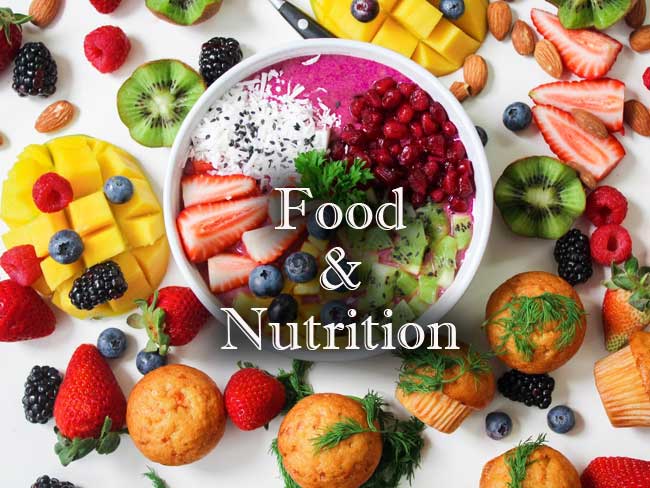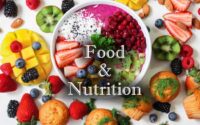Food and Nutrition Model Question Papers
In this Article, we have provided the Food and Nutrition Model Question Papers along with Solutions. So, the interested candidates who applied for jobs in Food and Nutrition can download Food and Nutrition Model Question Papers for free of cost. Get all the Food and Nutrition Model Question Papers with just one click.

Click on the enclosed links below to download the Food and Nutrition Model Question Papers. Check the Last five years Food and Nutrition Model Question Papers to get a clear idea of the exam pattern. Along with Food and Nutrition Model Question Papers, it’s better to refer Food and Nutrition Syllabus & Exam Pattern before starting preparation. So, click on link to check and download Food and Nutrition Model Question Papers PDF.
Model Question Papers on Food and Nutrition
1. Which of the following is not a correct example of fortified food as per the FSSATI definition of food fortification ?
(1) Iodized salt
(2) Milk with added vitamin D
(3) Edible oils with added vitamin D
(4) Mixed grain atta with added wheat bran
2. Food Safety and Standards (Organic Foods) Regulation was notified in which year ?
(1) 2016
(2) 2019
(3) 2017
(4) 2018
3. Liquefaction of starch to dextrin is carried out by which enzyme ?
(1) a-amylase
(2) Cellulase
(3) Pectinase
(4) Protease
4. What are the key stages of new product development as per the shorter developmental timeline ?
(1) Idea genesis, evaluation, food product development, pricing
(2) Idea genesis and evaluation, early food development, introduction in market, evaluation and advance development.
(3) Idea generation, food product development, market trial, advance development.
(4) Market research, food product development, market trial, advance development.
5. Which of the following enhances the absorption of iron in body ?
(1) Calcium
(2) Tannins
(3) Ascorbic acid
(4) Phytates
6. When a purine or pyrimidine is linked to a phosphorylated sugar residue, the resulting compound is called as:
(1) Nucleoside
(2) Nucleotide
(3) Ribonucleic acid
(4) Deoxyribonucleic acid
7. What is the end product of purine metabolism from food ?
(1) Uric acid
(2) Uric oxalates
(3) Cystine
(4) Pyridoxine
8. Cyanocobalamin is the chemical name of which vitamin ?
(1) Vitamin B12
(2) Vitamin D
(3) Vitamin C
(4) Vitamin E
9. Adipose tissue produces which of the following hormone that regulates feeding and energy expenditure to maintain nearly constant body weight ?
(1) Vitamin D
(2) Leptin
(3) Glucagon
(4) Growth hormone
10. Which of the following hormone is not steroid ?
(1) Adrenocortical hormone
(2) Progesterone
(3) Insulin
(4) Oestrogen
11. What is the nature of Proteins ?
(1) Amphoteric
(2) Acidic
(3) Alkaline
(4) Crystalline
12. The arachidonic acid has how many double bonds in its structure ?
(1) 5
(2) 2
(3) 3
(4) 4
13. Glycerol obtained from the breakdown of fat is converted to
(1) Dihydroxyacetone phosphate
(2) Ribose 3 phosphate
(3) 1, 3 Bisphosglycerate
(4) 3-Phosphoglycerate
14. The formation of fatty acyl-Co A from Fatty acid occur in which part of the cell ?
(1) Nucleus
(2) Mitochondria
(3) Cytoplasm
(4) Ribosomes
15. How many ATPs are generated in complete oxidation of palmitic acid through beta oxidation and citric acid cycle ?
(1) 28
(2) 80
(3) 108
(4) 100
16. Which of the following has a higher melting point, boiling point, and heat of vaporization than most other common solvents ?
(1) Methanol
(2) Ethanol
(3) Acetone
(4) Water
17. Which of the following statements is not true regarding the pyruvate formed by glycolysis ?
(1) Reduction to lactic acid
(2) Alcohol fermentation
(3) Catabolism of pyruvic acid to CO2 and water through citric acid cycle.
(4) Conversion to succinyl coenzyme A
18. How many molecules of ATPs must be invested in preparatory phase of glycolysis ?
(1) 2
(2) 4
(3) 6
(4) 8
19. The mixture of dextrose and levulose produced after hydrolysis of sucrose is called :
(1) Caramel
(2) Invert sugar
(3) High density fructose sugar
(4) Glucose syrup
20. Which of the following vitamin is essential for decarboxylation reaction in glycolysis cycle ?
(1) Thiamine
(2) Riboflavin
(3) Folic acid
(4) Pantothenic acid
| Practice Papers | Quiz |
| Easy Question | Previous Question |
| Difficult Question | Sample Papers |
| Important Question | Model Papers |
| GK | Food Safety |
| MCQs |
21. What is the term used to express the degree of acidity or alkalinity of a food or a given solution ?
(1) Buffer
(2) Isoelectric point
(3) Hydrogen ion concentration — (pH)
(4) Redox Potential
22. Which of the following is a condition of increased accumulation of extracellular fluid ?
(1) Oedema
(2) Dehydration
(3) Water equilibrium
(4) Diuresis
23. What is the purpose of ashing in estimation of iron in food sample ?
(1) Destroy the organic matter
(2) Convert iron from ferric form to ferrous form
(3) Isolation of iron from food sample
(4) Assessment of availability of iron
24. Which of the following 1s used to neutralize free fatty acid for the determination of acid value in fat ?
(1) Cupric sulphate
(2) Alpha amyloglucosidase
(3) Potassium hydroxide
(4) Ammonium hydroxide
25. The first step in estimation of protein using Kjeldahl method is :
(1) Digestion of food sample
(2) Separation of amino acid
(3) Precipitation of protein by perchloric acid
(4) Distillation process
26. Which of the following methods offers a high degree of analytical selectivity in addition to great speed of separation ?
(1) Spectrophotometry
(2) Paper chromatography
(3) Titramety
(4) High pressure liquid chromatography
27. Which of the following laws states that the optical density of a solution is directly proportional to the concentration of the solute ?
(1) Stefan’s law
(2) Beer’s law
(3) Pascal’ law
(4) Bernoulli’s law
28. In protein estimation, which of the following is converted to deeply coloured complex and then amino acids are evaluated densitometrically ?
(1) Hydroxyproline
(2) Hydrochlorine
(3) Ninhydrin
(4) Bromothymol
29. To determine oxalic acid in food products, what is oxalic acid precipitated to and then that is titrated against standard potassium permanganate ?
(1) Potassium oxalate
(2) Ammonium oxalate
(3) Calcium oxalate
(4) Cupric oxalate
30. Which of the following (in milligrams) is required to neutralize the free fatty acids present in one gram of fat is known as acid value ?
(1) Cupric sulphate
(2) Alpha amyloglucosidase
(3) Potassium hydroxide
(4) Ammonium hydroxide
31. The protein content determined by Kjeldahl method is by the estimation of :
(1) Protein
(2) Nitrogen
(3) Ammonia
(4) Ammonium sulphate
32. Urea in the liver is formed from :
(1) Two ammonia mols and one mole of CO2
(2) Two ammonia mols and two moles of CO2
(3) One ammonia mols and one mole of CO2
(4) One ammonia mols and two moles of CO2
33. The non-amino residue of an amino acid is called :
(1) Keto acid
(2) Lactic acid
(3) Aspartic acid
(4) Citric acid
34. Dinitro phenyl hydrazine method used to estimate which of the following in foodstuffs ?
(1) Vitamin B
(2) Ascorbic acid
(3) Lipid value
(4) Antioxidant content
35. Which of the following is not a function of muscle ?
(1) Heat production
(2) Maintaining body posture
(3) Stability of joints
(4) Connect bone to bone
36. Which of the following muscles are controlled voluntarily ?
(1) Skeletal muscles
(2) Cardiac muscles
(3) Smooth muscles
(4) (2) and (3) both
37. Which of the following hormones stimulate the production of pancreatic juice and bicarbonate ?
(1) Insulin and glucagon
(2) Cholecystokinin and secretin
(3) Gastrin and insulin
(4) Angiotensin and epinephrine
38. Which of the following regulates the body temperature ?
(1) Spinal cord
(2) Hypothalamus
(3) Thyroid gland
(4) Skin
39. Meaning of diuresis is :
(1) Production of urine in excess to normal level
(2) Reduction of urine production
(3) Increase in urea levels of blood
(4) Decrease in urea level of blood
40. Which of the following type of joint is present in hip joint ?
(1) Ball and socket joint
(2) Hinge joint
(3) Plane joint
(4) Pivot joint
41. Which of the following enzyme converts soluble fibrinogen into insoluble fibrin ?
(1) Thrombin
(2) Prothrombinase
(3) Chymotrysinogen
(4) Thromboplastin
42. Which of the following blood constituents protects body from pathogens by phagocytosis ?
(1) Red blood corpuscles
(2) White blood cells
(3) Platelets
(4) Plasma
43. Life Span of Red blood cells is :
(1) 100 days
(2) 120 days
(3) 80 days
(4) 140 days
44. Which of the following hormone triggers ovulation ?
(1) Luteimizing hormone
(2) Prolactin
(3) Thyroid stimulating hormone
(4) Oxytocin
45. Action of parathormone in the human body :
(1) Decreases blood sodium level
(2) Increases blood sodium level
(3) Decreases blood calcium level
(4) Increases blood calcium level
46. The cerebrospinal fluid provides :
(1) Mechanical protection
(2) Immunity
(3) Chemical protection
(4) Circulation of nutrients
47. Which of the following is not a part of neuron ?
(1) A cell body
(2) Dendrites
(3) Axon
(4) Glycolytic fibres
48. The maximum reabsorption of water takes place in which of the following part of nephron ?
(1) Proximal convoluted tubule
(2) Loop of Henle
(3) Distal convoluted tubule
(4) Collecting duct
49. Which of the following does not regulate Glomerular filtration rate ?
(1) Renal auto regulation of GFR
(2) Neural regulation of GFR
(3) Hormonal regulation of GFR
(4) Chemical regulation of ions
50. Which part of the nephron does not take part in the reabsorption of water and nutrients ?
(1) Bowman’s capsule
(2) Proximal convoluted tubule
(3) Loop of Henle
(4) Distal convoluted tubule

